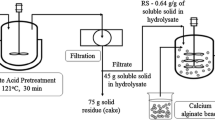Abstract
The quantitative effects of temperature, pH and time of fermentation were investigated on simultaneous saccharification and fermentation (SSF) of ethanol from sago starch with glucoamylase (AMG) and Zymomonas mobilis ZM4 using a Box–Wilson central composite design protocol. The SSF process was studied using free enzyme and free cells and it was found that with sago starch, maximum ethanol concentration of 70.68 g/l was obtained using a starch concentration of 140 g/l, which represents an ethanol yield of 97.08%. The optimum conditions for the above yield were found to be a temperature of 36.74 °C, pH of 5.02 and time of fermentation of 17 h. Thus by using the central composite design, it is possible to determine the accurate values of the fermentation parameters where maximum production of ethanol occurs.
Similar content being viewed by others
References
Bowman, L. & Geiger, E. 1984 Optimization of fermentation conditions for alcohol production. Biotechnology and Bioengineering 26, 1492-1497.
Box, G.E.P. & Wilson, K.B. 1951 On the experimental attainment of optimum conditions. Journal of the Royal Statistical Society (Series B) 13, 1-45.
Caputi, A. & Wright, D. 1969 Collaborative study of the determination of ethanol in wine by chemical oxidation. Journal of AOAC International 52, 85-88.
Chen, S.L. 1981 Optimization of batch alcohol fermentation of glucose syrup substrate. Biotechnology and Bioengineering 23, 1827-1836.
Cheynier, V., Feinberg, M., Chararas, C. & Ducauze, C. 1983 Application of response surface methodology to evaluation of bioconversion experimental conditions. Applied and Environmental Microbiology 45, 634-639.
Cochran, N.G. & Cox, G.M. 1968 Experimental Designs. John Wiley and Sons Inc., p. 611.
Elisson, A., Hofmeyr, J.H.S., Pedler, S. & Hahn-Hagerdal, B. 2001 The xylose reductase/xylitol dehydrogenase/xylulokinase ratio a.ects product formation in recombinant xylose-utilizing Saccharomyces cerevisiae. Enzyme and Microbial Technology 29, 288-297.
Galas, E., Bieleeki, S., Antezak, T., Weiczorek, A. & Blaszezyk, R. 1981 Optimization of cultivation medium conditions for lytic enzyme biosynthesis. In Advances in Biotechnology. Proceedings of the 6th International Fermentation Symposium, Vol. 3. eds. Moo-Young, M., Vezina, C., Singh, K. pp. 301-306. Canada: Pergamon Press. ISBN 0-08025385-7.
Kosaric, N., Wieczorek, A., Cosentino, G. & Magee, R. 1983 In Biotechnology, vol. 3. ed. Dellweg, H. p. 315. (Weinheim, Verlag Chemie) ISBN 3-52725765-9.
Lee, J.M. & Woodward, J. 1983 Properties and application of immobilized ?-D-glucoside coentrapped with Zymomonas mobilis in calcium alginate. Biotechnology and Bioengineering 25, 2441.
Maddox, I.S. & Reichert, S.H. 1977 Use of response surface methodology for the rapid optimization of microbiological media. Journal of Applied Bacteriology 43, 197-204.
Miller, G.L. 1959 Use of DNS reagent for determination of reducing sugars. Analytical Chemistry 31, 426-428.
Moresi, M., Colicchio, A. & Sansovini, F. 1980 Optimization of whey fermentation in a jar fermenter. European Journal of Applied Microbiology and Biotechnology 9, 173-183.
Ratnam, B.V.V. 2001 Studies on physico-chemical and nutritional parameters for the production of ethanol from palmyra jaggery by submerged fermentation using Saccharomyces cerevisiae. PhD Thesis, Andhra University, Visakhapatnam, AP, India.
Tan, K. 1980 Production of sago starch. In Proceedings of the Second International Sago Symposium. eds. Stanton, W.R. & Flach, M. p. 56. (The Hague: Martinus Nijho.) ISBN 90-2472470-8.
Swinkels, J.J.M. 1985 In Starch Conversion Technology, eds. van Beynum, G.M.A., Roels, J.A. p. 23. New York: Marcel Dekker. ISBN 0-82477194-X.
Zertuche, L. & Zall, R.R. 1985 Optimizing alcohol production from whey using computer technology. Biotechnology and Bioengineering 27, 547-554.
Author information
Authors and Affiliations
Rights and permissions
About this article
Cite this article
Ratnam, B., Narasimha Rao, M., Damodar Rao, M. et al. Optimization of fermentation conditions for the production of ethanol from sago starch using response surface methodology. World Journal of Microbiology and Biotechnology 19, 523–526 (2003). https://doi.org/10.1023/A:1025174731814
Issue Date:
DOI: https://doi.org/10.1023/A:1025174731814




